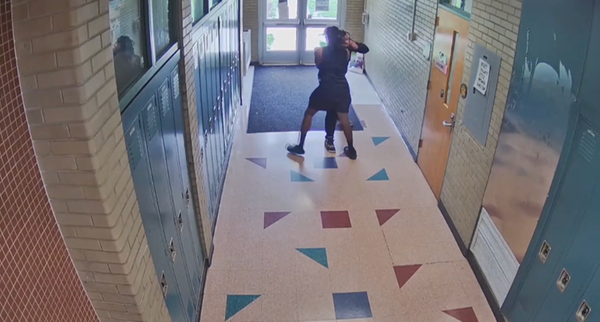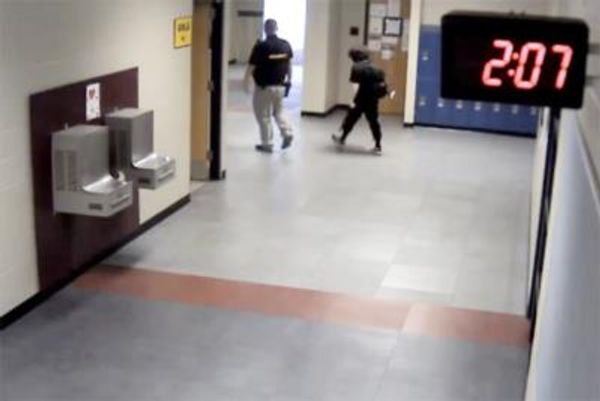
“I’m a bit nervous,” says Milena Piaguaje, a 19-year-old director from the Ecuadorian Amazon. On a warm evening in the small town of Puerto Misahuallí, Piaguaje and her friend and fellow director Magdalena Quenamá are preparing to show their films to a festival audience for the first time.
Quenamá, 19, from the A’i Cofán community of Dureno, says her film, Chimindi’s Vision (Chimindi Athe’pa), “is a call-out for the youngsters of my community, which is gradually losing its traditions”. In it, she explores the practice of accessing the spiritual world through the consumption of a sacred drink called yoco.
Piaguaje’s short, The Memory of the Hands (Jëña Kwasasaoye), follows the making of shigra woven fabric to preserve the memory of her people. “Those who are my age are persuaded that the western world is better than ours,” she says. Yet she feels that her Indigenous community, Siekoya Remolino, is still unharmed by highways, hotel chains or palm oil monocultures.

Piaguaje and Quenamá both see making movies as a way to protect their past and guarantee their future. It is a sentiment shared by all the Indigenous film-makers taking part in Kanua, the first floating film festival in the Amazon. For the past two weeks, a solar-powered boat has travelled to Amazonian Indigenous territories on the banks of the Bobonaza, Pastaza and Capahuari rivers showing Indigenous productions to communities that had never hosted a film festival before.
Despite their diversity – 29 films from nine countries and 27 communities – the featured films tackle common themes, such as Indigenous rights, environmental preservation and other climate justice issues at the centre of international debate.
Sani Montahuano, 26, an Indigenous film-maker and producer at Kanua, says: “When we are in charge of the audiovisual, we show the world how we see ourselves, how we understand our spiritual world and how we interpret the spaces that surround us.”
With Indigenous ways of life systematically attacked and communities often torn apart, Montahuano believes the screening of these films in Indigenous territories can create a sense of alliance. “It’s time to create our own script,” she says.

Raised between the city of Puyo and the Sápara community of Llanchama Cocha, Montahuano started using audiovisuals in her early 20s to talk about, among other stories, the importance of spirituality in her community.
“Interpreting dreams is a very important tradition for us. We inhale tobacco to remember our dreams and connect with them. The Sápara say: ‘We dream to live, and we live to dream,’” she says. To this day, no church has managed to enter the Llanchama Cocha community. “We have no such thing as a Sunday Mass,” she adds.
In 2019, Montahuano and her brother founded Tawna, a multicultural film organisation focused on Amazonian narratives, which co-organised Kanua with Kara Solar, a clean energy foundation.

Among the spectators at the Kanua pre-premiere on 22 November was Elizabeth Andi, 27, an artist and storyteller from the Kichwa community of Venecia Derecha, and her younger cousin, who was thrilled to spot a friend in one of the films.
“Cinema is like a bridge,” says Andi. “If my younger cousins see people like them, from their generation, doing amazing stuff on the screen, they feel inspired.
“Outsiders have historically accessed a distorted representation of the Amazon, associating the region exclusively with its animals and vegetation. They forget that the Amazon is also made of people and that we have stories to tell.”
***
After a four-hour bus ride from Puerto Misahuallí, and a three-hour boat trip along the Bobonaza River, Kanua arrives in the Kichwa Indigenous territory of Sarayaku for the opening of the festival on 24 November.

Sarayaku is known in Ecuador and abroad for protecting Indigenous rights: 11 years ago, the community won a case at the Inter-American court of human rights against Ecuador State, which had granted a private company the permit to extract oil from Sarayaku’s territory. Ecuador was held responsible for violating the Indigenous right to consultation.
Respecting tradition is at the heart of Sarayaku life. Their diet includes homegrown foods such as peanuts, cassava and plantain, and avoids ultra-processed products. Curacas, lower-level administrators, are elected by the community every year, and Kichwa, their mother tongue, is widely spoken; Spanish is only used to communicate with outsiders.
While tradition is pretty much synonymous with Sarayaku, an Indigenous film festival is the kind of progression that aligns with the aims of the community.

“We have already displayed films here, but never hosted a film festival. Youngsters must understand that Eriberto [Gualinga, a Sarayaku film-maker] shouldn’t be an exception,” says Samaï Gualinga, 34, the vice-president of the community. “This helps them see cinema as a door, through which they can become film-makers in the future.”
As the sun begins to set, curious children gather around the big screen. By 7pm, groups of teenage boys, older ladies and families have arrived to experience their first film festival. Many have rarely seen a movie before.
“The only time I’ve been to the cinema was in the late 1990s, to watch Titanic in Puyo,” says Dorila Matchoa, while her husband, Vinicio Viteli, a Sarayaku curaca, can’t remember the last time he watched a movie.
Tulio Gualinga, 30, has travelled abroad several times as international relations director of Sarayaku, but he has never been to a movie theatre before. “We should do more initiatives like this here in the community,” Tulio says.

Among the films being screened is Yoco Cofán: Wisdom and Territory (Yoco Cofán: sabiduría y território), directed by an A’i Kofan film-maker, Nixon Danny Andy Narvaez. At 26, Narvaez had already co-directed a documentary but feels proud that his first solo film project is part of the programme.
“It tells the struggle of Sinangoe, my community, to protect our territory. Our struggle has inspired Indigenous peoples not only in Ecuador but in Colombia and other parts of the world,” says Narvaez. So far, the Sinangoe community has successfully blocked at least 52 mining companies’ permits through Ecuador’s courts.
Narvaez sees film-making as a powerful tool for change. “Sometimes no one else is telling what’s going on in here. If we have these tools, and we don’t spread this message, who else will?” he says.
Quenamá and Piaguaje are two of the few female students still involved in film-making at the Alianza Ceibo project; since they started studying two years ago most women have left to get married or became pregnant, they say.
Quenamá now plans to make a fiction inspired by the last female shaman of her community and a documentary about her people’s food culture. “The audiovisual enters your heart and, little by little, you see yourself blossoming,” she says.

Since the film festival, “my friends have been asking me to cast them for my future films,” says Piaguaje. She wants to produce a documentary about the inspiring young women she met at film school, and hopes to motivate other Indigenous youngsters through her films.
“I want this film-making community to grow and, together, we can help each other tell our own stories.”







